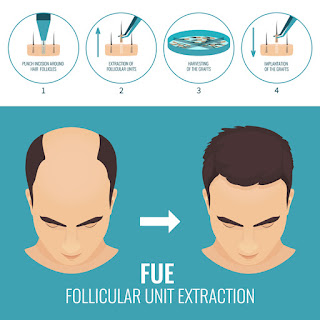Can body hair be used for FUE hair transplant surgery?
Follicular unit extraction hair transplant (FUE) can be a rewarding option for those wishing to restore their hairline and hair density. It is a popular choice for many people.
FUE uses a range of devices designed specifically to remove clusters of hair follicles from the scalp. These follicular units are present in one, two, three or four hairy families. Once removed from the back and sides of the skull, they can be implanted in the sparse areas of the skull to restore density where it is needed.
In strip harvesting (FUT / FUG), hair follicles are cut from the back of the scalp into a long strip of skin that can be 15–20 cm in length. The donor follicles are dissected into individual grafts under a microscope and implanted into the desired area of the skull. However, FUT / FUG leaves patients with a permanent linear scar on the back of the scalp, which can be difficult to cover, unless you grow your hair back long enough to cover it. Click here to learn more about why we do not do FUT / FUG at Melbourne Hair Transplant Clinic.
We believe that FUE is the best way to achieve a natural looking hairline, without the lack of a prominent linear scar. How do you know that you are a suitable candidate for such a transplant?
Traditional method
The standard method of FUE involves cutting the hair follicles from the back of the head and transplanting them to designed areas of the scalp. In most cases, the back of the skull is the right place to cut the follicles for FUE transplantation. This area of hair is usually not susceptible to hormones that cause male pattern hair loss and head crowns. Despite this, the region may still not be an ideal donor field, here are some examples:
- If the hair density on the back of the head is too thin - if the donor grafts / follicles are removed from the scalp when the density is lacking, the thickness of this area will be affected, which appears thinner than pre-surgery.
- If the patient has had FUT / FUG surgery in the past - this procedure leaves a noticeable scar after transplant. This method reduces hair density because it can damage the hair follicles near the removed strip of skin.
- There may not be enough follicles on the back of the head to cut - we cannot perform FUE if we are not to remove hair.
- An alternative method
- If it is not appropriate to cut the follicles behind the skull, then the next step is to locate a body hair transplant (BHT).
The Body hair transplant cuts hair from the neck, chest, back or thigh and applies individual grafts to the head. Although it is a relatively new option, the results have shown it to be a powerful alternative. Typically, we expect to see an 80% success rate from this solution, allowing people the chance to restore their hairline even if they do not use ROMs from the back of the head.
The Body hair transplant process is more complex than the standard FUE due to the nature of body hair. Naturally, body hair does not all grow in the same direction as it does on the head. Skin also varies greatly in elasticity, which can make the extraction of these follicles more laborious for the hair transplant surgeon and is therefore a more expensive procedure.
Key to Success
Because of these additional challenges, it is recommended that anyone considering BHT receive a test patch. By performing a test patch, the surgeon can assess the quality of hair growth and assess the patient's chances of success before a full body hair transplant.
Overall, the most effective way to find out your suitability for both FUE and BHT is to talk to a qualified surgeon, such as our own highly skilled Dr. Peter Parskeves. This is the only guaranteed way to fully understand which solution may suit you.
key Takeaways
- FUE typically uses donor hair from the back of the head, but sometimes there are cases where this hair cannot be used, such as low hair density on the back of the head, or strip surgery (FUT / FUG) from major mark.
- BHT is a good option for people not suitable for traditional FUE.
- A test patch needs to be implanted first to measure the potential success of BHT surgery.
- It is always best to discuss your options with an experienced surgeon.
- If you are interested in discovering your suitability for BHT or FUE, book a consultation today and let our knowledgeable team guide you.



Comments
Post a Comment